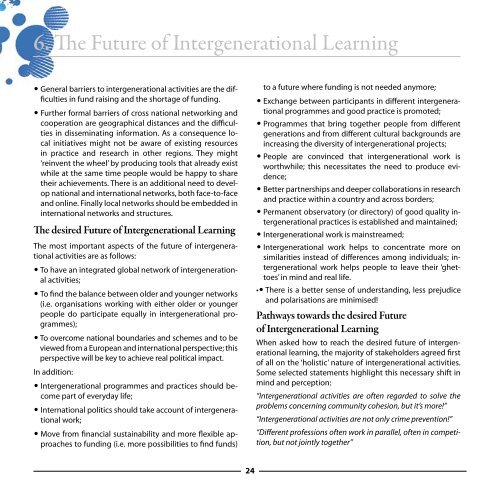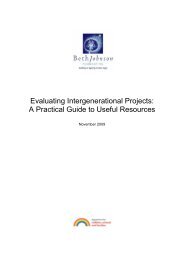Intergenerational Learning in Europe – Policies, Programmes ...
Intergenerational Learning in Europe – Policies, Programmes ...
Intergenerational Learning in Europe – Policies, Programmes ...
Create successful ePaper yourself
Turn your PDF publications into a flip-book with our unique Google optimized e-Paper software.
6. The Future of <strong>Intergenerational</strong> <strong>Learn<strong>in</strong>g</strong>• General barriers to <strong>in</strong>tergenerational activities are the difficulties<strong>in</strong> fund rais<strong>in</strong>g and the shortage of fund<strong>in</strong>g.• Further formal barriers of cross national network<strong>in</strong>g andcooperation are geographical distances and the difficulties<strong>in</strong> dissem<strong>in</strong>at<strong>in</strong>g <strong>in</strong>formation. As a consequence local<strong>in</strong>itiatives might not be aware of exist<strong>in</strong>g resources<strong>in</strong> practice and research <strong>in</strong> other regions. They might‘re<strong>in</strong>vent the wheel’ by produc<strong>in</strong>g tools that already existwhile at the same time people would be happy to sharetheir achievements. There is an additional need to developnational and <strong>in</strong>ternational networks, both face-to-faceand onl<strong>in</strong>e. F<strong>in</strong>ally local networks should be embedded <strong>in</strong><strong>in</strong>ternational networks and structures.The desired Future of <strong>Intergenerational</strong> <strong>Learn<strong>in</strong>g</strong>The most important aspects of the future of <strong>in</strong>tergenerationalactivities are as follows:• To have an <strong>in</strong>tegrated global network of <strong>in</strong>tergenerationalactivities;• To f<strong>in</strong>d the balance between older and younger networks(i.e. organisations work<strong>in</strong>g with either older or youngerpeople do participate equally <strong>in</strong> <strong>in</strong>tergenerational programmes);• To overcome national boundaries and schemes and to beviewed from a <strong>Europe</strong>an and <strong>in</strong>ternational perspective; thisperspective will be key to achieve real political impact.In addition:• <strong>Intergenerational</strong> programmes and practices should becomepart of everyday life;• International politics should take account of <strong>in</strong>tergenerationalwork;• Move from f<strong>in</strong>ancial susta<strong>in</strong>ability and more flexible approachesto fund<strong>in</strong>g (i.e. more possibilities to f<strong>in</strong>d funds)to a future where fund<strong>in</strong>g is not needed anymore;• Exchange between participants <strong>in</strong> different <strong>in</strong>tergenerationalprogrammes and good practice is promoted;• <strong>Programmes</strong> that br<strong>in</strong>g together people from differentgenerations and from different cultural backgrounds are<strong>in</strong>creas<strong>in</strong>g the diversity of <strong>in</strong>tergenerational projects;• People are conv<strong>in</strong>ced that <strong>in</strong>tergenerational work isworthwhile; this necessitates the need to produce evidence;• Better partnerships and deeper collaborations <strong>in</strong> researchand practice with<strong>in</strong> a country and across borders;• Permanent observatory (or directory) of good quality <strong>in</strong>tergenerationalpractices is established and ma<strong>in</strong>ta<strong>in</strong>ed;• <strong>Intergenerational</strong> work is ma<strong>in</strong>streamed;• <strong>Intergenerational</strong> work helps to concentrate more onsimilarities <strong>in</strong>stead of differences among <strong>in</strong>dividuals; <strong>in</strong>tergenerationalwork helps people to leave their ‘ghettoes’<strong>in</strong> m<strong>in</strong>d and real life.•• There is a better sense of understand<strong>in</strong>g, less prejudiceand polarisations are m<strong>in</strong>imised!Pathways towards the desired Futureof <strong>Intergenerational</strong> <strong>Learn<strong>in</strong>g</strong>When asked how to reach the desired future of <strong>in</strong>tergenerationallearn<strong>in</strong>g, the majority of stakeholders agreed firstof all on the ‘holistic’ nature of <strong>in</strong>tergenerational activities.Some selected statements highlight this necessary shift <strong>in</strong>m<strong>in</strong>d and perception:“<strong>Intergenerational</strong> activities are often regarded to solve theproblems concern<strong>in</strong>g community cohesion, but it’s more!”“<strong>Intergenerational</strong> activities are not only crime prevention!”“Different professions often work <strong>in</strong> parallel, often <strong>in</strong> competition,but not jo<strong>in</strong>tly together”24






